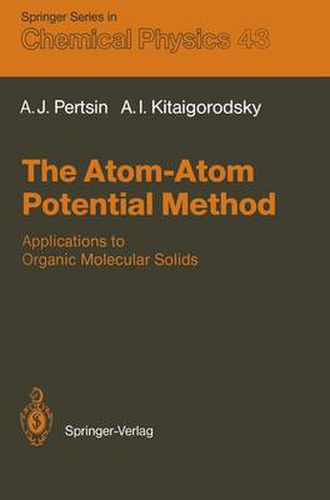Readings Newsletter
Become a Readings Member to make your shopping experience even easier.
Sign in or sign up for free!
You’re not far away from qualifying for FREE standard shipping within Australia
You’ve qualified for FREE standard shipping within Australia
The cart is loading…






This title is printed to order. This book may have been self-published. If so, we cannot guarantee the quality of the content. In the main most books will have gone through the editing process however some may not. We therefore suggest that you be aware of this before ordering this book. If in doubt check either the author or publisher’s details as we are unable to accept any returns unless they are faulty. Please contact us if you have any questions.
The history of physics furnishes many examples of how a simple semiem pirical method, essentially based on intuitive considerations, may prove to be much more successful than a rigorous theoretical approach. A pertinent example is the method of atom-atom potentials, which treats the intermolec ular interactions between polyatomic molecules in terms of pairwise inter actions between their constituent atoms. Despite a few conceptual short comings, the method provides a fairly reliable practical means of handling, on a microscopic level, a wide range of problems that arise in the solid-state physics and chemistry of organic compounds. This monograph is an attempt to generalize the experience gained in the past twenty years in interpreting the static and dynamic properties of organic molecular solids in terms of atom-atom potentials. It embraces nearly all aspects of the application of the method, including an evaluation of cohesive energies, equilibrium crystal structures, phonon spectra, ther modynamic functions, and crystal defects. Many related topics such as the effect of the crystal field on molecular conformation, the determination of crystal structures from raw diffraction data, and the problem of polymor phic transitions are also discussed. We believe that this book will be of use to researchers in solid-state physics, chemistry, crystallography, physical chemistry, and polymer chem istry. It also gives us an opportunity to acknowledge our indebtedness to those who sent us published as well as unpublished information and sugges tions, including A.T. Amos, E.L. Bokhenkov, H. Bonadeo, R.K. Boyd, C.P.
$9.00 standard shipping within Australia
FREE standard shipping within Australia for orders over $100.00
Express & International shipping calculated at checkout
This title is printed to order. This book may have been self-published. If so, we cannot guarantee the quality of the content. In the main most books will have gone through the editing process however some may not. We therefore suggest that you be aware of this before ordering this book. If in doubt check either the author or publisher’s details as we are unable to accept any returns unless they are faulty. Please contact us if you have any questions.
The history of physics furnishes many examples of how a simple semiem pirical method, essentially based on intuitive considerations, may prove to be much more successful than a rigorous theoretical approach. A pertinent example is the method of atom-atom potentials, which treats the intermolec ular interactions between polyatomic molecules in terms of pairwise inter actions between their constituent atoms. Despite a few conceptual short comings, the method provides a fairly reliable practical means of handling, on a microscopic level, a wide range of problems that arise in the solid-state physics and chemistry of organic compounds. This monograph is an attempt to generalize the experience gained in the past twenty years in interpreting the static and dynamic properties of organic molecular solids in terms of atom-atom potentials. It embraces nearly all aspects of the application of the method, including an evaluation of cohesive energies, equilibrium crystal structures, phonon spectra, ther modynamic functions, and crystal defects. Many related topics such as the effect of the crystal field on molecular conformation, the determination of crystal structures from raw diffraction data, and the problem of polymor phic transitions are also discussed. We believe that this book will be of use to researchers in solid-state physics, chemistry, crystallography, physical chemistry, and polymer chem istry. It also gives us an opportunity to acknowledge our indebtedness to those who sent us published as well as unpublished information and sugges tions, including A.T. Amos, E.L. Bokhenkov, H. Bonadeo, R.K. Boyd, C.P.